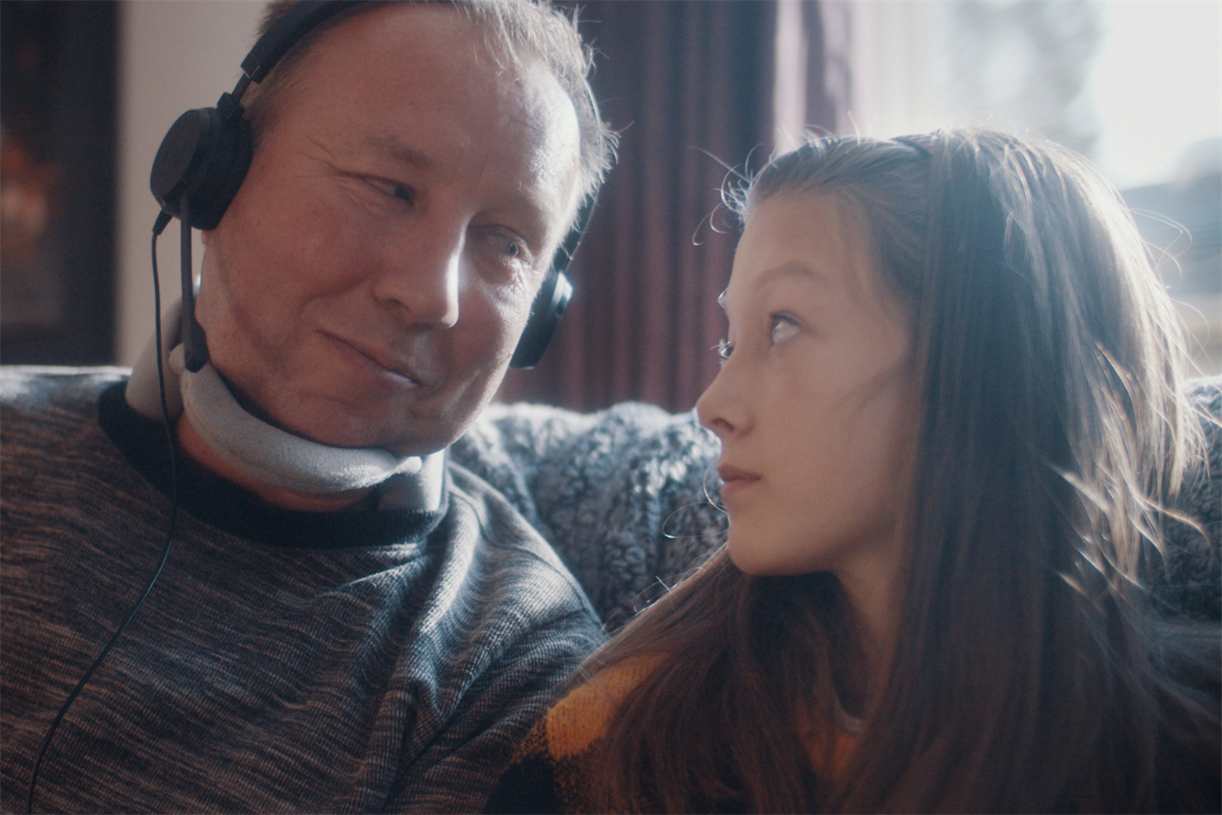The Ultimate Guide to Storytelling
Storytelling is an art. Like art, it requires creativity, vision, skill, and practice. It's a crucial part of the most successful marketing campaigns, and it sets vibrant brands apart from simple businesses and loyal consumers from one-time stop-in shoppers....

Storytelling is an art. Like art, it requires creativity, vision, skill, and practice. It's a crucial part of the most successful marketing campaigns, and it sets vibrant brands apart from simple businesses and loyal consumers from one-time stop-in shoppers. It’s a valuable tool for all marketers to have in their tool belts, and it's the heart of inbound marketing. This post is a guide to help you discover and understand storytelling and weave gorgeous, compelling tales for your audience. Pick up your pen, and let’s dive in. Storytelling uses words to create new worlds and experiences in a reader or listener's imagination. Storytelling can impact human emotions. It can also lead people to accept original ideas or encourage them to take action. Since storytelling can take so many forms, creating a good story can be challenging. Here are some quick do’s and don’ts to get you started: Since the dawn of human language, storytelling has been how cultures pass on shared beliefs and values. Some of the stories told today come from stories our ancestors were shared over 6,000 years ago. Every person has a story, but the art of storytelling can make a story transformative. There are a few qualities that can push a basic story into the art of storytelling. All great stories have a narrative, which is a spoken or written account of events that are influenced by a setting. For example, stand-up comics tell stories during a set, and while the structure, setting, and details of the narrative may not feel the same as they do in a Shakespeare play, both share a narrative. Just telling a story isn’t enough — you want one that resonates and grabs attention. One great way to do so is to create suspense which attracts audiences with unanswered questions and an interest to learn more and answer those questions. Surprising your audience is also a great way to pull readers in. Another way is to “Show, don’t tell,” where you captivate with details that bring your story to life. For example, say your company is launching a new product. You can share details about when your team came up with the idea, which is more exciting than telling customers you’re about to release the best new product. Talk about the roadblocks and small wins; make your audience feel part of your process. Storytelling isn’t just the story you tell — it’s how your audience responds and engages. Some kinds of storytelling require people to participate in the story, like the Netflix interactive show Kaleidoscope, where viewers customize the order they watch episodes. But with most stories, the interaction comes from the relationship the audience builds with the storyteller. Your audience might be a fan group for the latest Harry Potter movie. And your favorite storyteller could be a TikTok influencer. That feeling of connection and interaction is essential to storytelling. Many movies come from popular books, and it's not unusual for viewers to rate the quality of a book-based movie on its ability to match what they imagined as they read the book. When someone listens to storytelling, they might develop a visual for the story in their mind, and it can be incredibly detailed and include the characters, setting, and events. Stories can pull up memories, and people might see themselves represented in story characters. Telling a story is essentially painting a picture. While everyone can tell a story, you can fine-tune your storytelling skills and become a storyteller for your organization, brand, or business. These people are typically marketers, content writers, or PR professionals. Every member of an organization can tell a story. But before we get into the how, let’s talk about why we tell stories — as a society, culture, and economy. Some of the main reasons to tell stories are to sell, entertain, and educate. But why choose storytelling over a data-driven PowerPoint or a bulleted list? Why are stories are a go-to way of sharing, explaining, and selling information? Here’s why. Understanding new ideas can be confusing; stories can offer a way around that. Think about times when stories have helped you better understand a concept. Maybe a teacher used a real-life example to explain a math problem, or a speaker used a case study to convey complex data. Stories help solidify abstract concepts and simplify complex messages. Taking a lofty, non-tangible concept and making it relatable using concrete ideas is one of the biggest strengths of business storytelling. Take Apple, for example. Computers and smartphones can be complicated topics to describe to everyday consumers. The business uses real-life stories to explain exactly how its products work and benefit users. It uses storytelling instead of relying on technical jargon to convince consumers to buy its products over a competitor. Peoplehave used stories to promote cooperation and influence social behaviors throughout history. Listening to stories also engages different parts of the brain than data does. And there is scientific evidence that stories can change our behavior because they engage our emotions. If you’re good at storytelling, you might influence the future behavior of your audience by asking someone to see a series of events from your perspective. For example, even if you’re still stressed out and overwhelmed, you can still connect with a story, and a connection might lead you to be less critical about facts, less defensive, and more open to changing your ideas. Cultures often honor skilled storytellers because they also appreciate brands that tell stories to promote societal values, like this example of Ben & Jerry’s supporting the People’s Response Act. Stories are a universal language; they can bring people together and create a sense of community. Despite any barriers and differences, stories connect us through feelings and how we respond to them. We all understand the story of the hero, the underdog, or heartbreak. We all process emotions and can share feelings of elation, hope, despair, and anger. Sharing a story gives even the most diverse people a sense of commonality and community. TOMS is a great example of this. It shares stories of customers and the people it serves and has effectively created a movement that has driven sales and built a community eager to support TOMS and view its impact on the causes it supports. When brands get transparent and authentic, it brings them down-to-earth and helps consumers connect with them and the people behind them. Tapping into people’s emotions and bearing both the good and bad is how stories inspire, motivate, and drive action. Stories also foster brand loyalty by creating a narrative around your brand or product that humanizes it while marketing your business. Few brands use inspiration as a selling tactic, but ModCloth does it well. Sharing the real story of its business makes the brand relatable and worth purchasing and inspires other founders and business owners. Words like good are bad are relative to opinion, but there are a few non-negotiable components that make up all great stories. Good stories are: According to HubSpot Academy’s free Power of Storytelling course, a good story has three main components — regardless of the story you’re trying to tell. Every story features at least one character, and this character is key to relating your audience back to the story. The main character is the protagonist. Your characters form the bridge between you, the storyteller, and the audience. If your audience can put themselves in your character’s shoes, they’ll be more likely to follow through with your call-to-action. The conflict is the lesson of how the character overcomes a challenge. Conflict in your story elicits emotions and connects the audience through relatable experiences. When telling stories, the power is in what you convey and teach. If there’s no conflict in your story, it’s likely not a story. Every good story has a closing. Your resolution should wrap up the story, give context to the characters and conflict(s), and leave your audience with a call to action. If you’re new to storytelling, there are a couple of other elements you’ll want to think about as you build your first story. Your plot is the structure of your storytelling. A blog can have great writing and relatable characters. But if you don't create a natural flow of events, your blog will confuse your reader. A blog can have excellent writing and relatable characters, but lacking a natural flow can confuse your reader. For example, your “About” page on your website can run through your business’ story, but if you don’t break it into useful segments, your visitors might bounce before they get to the good part. Plots don't need to be in chronological order, and there are many ways to experiment with the structure of your story. But all stories should have a beginning, middle, and end. Your story's setting is more than where a story takes a place. It's how you can: For example, say you're creating an ad campaign that features two main characters. One runs a small startup and the other works for a large enterprise. Where would it make sense for these two to meet up? How could their location impact the conversation? These factors affect how audience absorb, understand, and relate to the story. We’ve explained that storytelling is an art that requires creativity, vision, and skill. It also requires practice. Enter: the storytelling process. Painters, sculptors, dancers, and designers all follow their own creative processes when producing their art. It helps them know where to start, how to develop their vision, and how to perfect their practice over time. The same goes for storytelling – especially for businesses writing stories. But, why is this process important? Because, as an organization or brand, you likely have a ton of facts, figures, and messages to get across in one succinct story. How do you know where to begin? Well, start with the first step. You’ll know where to go (and how to get there) after that. Who wants to hear your story? Who will benefit and respond the strongest? To create a compelling story, you need to understand your readers and who will respond and take action. Before you put pen to paper (or cursor to word processor), do some research on your target market and define your buyer persona(s). This process will get you acquainted with who might be reading, viewing, or listening to your story. Understanding who your story is for will also offer crucial direction as you build out the foundation of your story. It’s not that you can’t get by with a more basic understanding of your target audience; it just won’t help you go above and beyond in sharing stories your audience is interested in, wants to hear, and stories that inspire them. Our 2023 Marketing Trends Report found that, more than ever, data-driven marketers will win. Leveraging data can help you better reach your target audience, understand the most compelling stories, drive high ROI with your stories, and generally create better and more engaging and desired content. Like the foundation of a home, you need to set up your core message before moving forward. Is your story selling a product or raising funds? Explaining a service or advocating for an issue? What is the point of your story? To help define this, try to summarize your story in six to ten words. If you can’t do that, you don’t have a core message. Not all stories are created equal. To decide what kind of story you’re telling, figure out how you want your audience to feel or react as they read. This will help you figure out how you’re going to weave your story and what goal you’re pursuing. If your goal is to: Your story should describe how you completed a successful action in the past and explain how readers might be able to create the same kind of change. Avoid excessive, exaggerated detail or changes in the subject so your audience can focus on the action or change that your story encourages. Talk about your genuine, humanizing struggles, failures, and wins. Today’s consumer appreciates and connects to brands that market with authenticity. Your storytelling should reflect your authentic self. Tell stories that tap into familiar emotions, characters, and situations so readers can understand how it applies to their lives. Also, tell stories that convey your brand values, like causes you support and care for, whether directly or indirectly related to your brand. For example, you can share a case study about the impact of a fundraiser you created or explain the environmentally-conscious production process for your products. It’s an essential type of story to tell, as consumers care more than ever about what the brands they buy from stand for and whether their values align. They want to know about the causes you support and your commitments to bettering the world. If it seems like more of a niche type of story to share, it’s actually on the rise. In fact, 44% of marketers are already sharing this type of content, and it has the 5th highest ROI of any trend. Tell stories that move readers to discuss and share stories with others, stories where people might say, “Hey, me too.” Stories that foster this kind of community building inspire audiences to continue to come back to your business and develop connections with you and other people that are also impacted. Conversations that people have will help you learn more about your audiences and what they care for so you can create content more relevant to their needs. Community building is trending in marketing, and 90% of marketers say that building an active online community is crucial to success in 2023. Consumers also want to join communities (20% have joined one in the past three months). Educational content is anything that informs your audiences who are trying to solve problems, get an answer, or meet a need. They want help figuring out what to do, and your educational content will help them get there. Popular types of content you can use to tell educational stories are blog posts and YouTube videos. For example, You can tell a story with a trial-and-error experience for readers to learn about a problem and how you applied a solution. This can help people facing a similar problem discover how to tackle it and expose you to new audiences who might be searching for resources to solve their issue but have yet to hear of you. Fun fact: Website/seo/blogs have the highest ROI of any marketing channel. Your objective and call-to-action (CTA) are similar, but your CTA will establish the action you’d like your audience to take after reading. What exactly do you want your readers to do after reading? Do you want them to donate money, subscribe to a newsletter, take a course, or buy a product? Outline this alongside your objective to make sure they line up. For example, if your objective is to foster community or collaboration, your CTA might be to "Tap the share button below." Stories can take many shapes and forms. Sometimes people read stories. Other times they watch or listen., Your chosen story medium depends on your type of story as well as resources, like time and money. Here are four different ways you can tell your story: Written stories can be articles, blog posts, books — anything that’s mostly and primarily text. Written stories are by far the most affordable, attainable method of storytelling as it can simply require a free word processor like Google Docs or a pen and paper. You tell spoken stories in person, like in a presentation, pitch, or panel. TED talks are an example of spoken stories. Because of their "live", unedited nature, spoken stories typically require more practice and skill to convey messages and elicit emotions in others. Audio stories are spoken aloud but recorded — that’s what sets them apart from the spoken story. Audio stories are usually in podcast form, and with today’s technology, creating an audio story is more affordable than ever. (For great story-driven podcasts, check out The HubSpot Podcast Network.) Digital storytelling comes in a variety of media formats like: Digital storytelling is a highly effective format for emotionally resonant and active visual stories. Given this, they can sometimes be expensive to produce and require higher budgets. The great thing is that consumers often don’t mind lower video quality and production value as much as conveying a strong message. You have an idea of what you want to include in your story, how you want to organize it, and what medium is best. If you were doing some creative writing, your next step might be to jump right into writing and work on the structure of your story later. But while storytelling in marketing is creative, it also has a goal in mind. This means it may need a more structured process because every step from the intro to CTA needs to meet a specific goal. Your storytelling should ignite imagination and emotion no matter where you share it. But marketing storytellers are also tracking metrics once their story goes out into the world. With this in mind, you may want to create a detailed outline of your story. You might develop storyboards, wireframes, or a PowerPoint presentation. These can help you stay focused as you craft your story. They can also help you keep your original vision of your story as you move through the approvals, meetings, and pitches that often come with business storytelling. Now it’s time to put pen to paper and start crafting your story. For many storytellers, this is the fun part. As of this writing, there are over 218,000,000 links on Google for the search "writer's block." If you feel stuck, you're not alone. But help is on the way. These excellent tips for writer’s block can help you if you feel stuck, and these quotes about storytelling can inspire you. Remember, you've got this. Every person is a storyteller, and audiences aren't just waiting for any old story. They want to hear from you. Don’t forget to share and promote your story. Like with any piece of content marketing, creating it is only half the battle — sharing is how your audience can complete your story. According to HubSpot Blog Research, here are some of the best ways and places to share your stories: According to our Media & Content Planning Report, email marketing is one of the most leveraged channels used by media planners, and it has the 3rd highest ROI of any channel. Social media is the top marketing channel with the highest ROI, so sharing your stories on the platform is bound to bring engagement and interaction for your business. The top platforms for sharing stories on social media are Facebook, Instagram, and YouTube. Many businesses also use a mix of organic and paid media to maximize the potential reach for their stories. Promote written stories on your blog, Medium, or by guest posting on other publications. According to marketers, video has the highest ROI of any media format, especially short-form video. While spoken stories are best conveyed in person, consider recording a live performance to share later. The more places you share your story, the more engagement you can expect from your audience. Storytelling is a trial-and-error process, and no one tells a story perfectly on the first try. That’s why we’ve collected these resources to help you fine-tune your storytelling skills and learn more about the different ways you can tell a story. Storytelling is an art. It’s also a process worth learning for both your business and your customers. Stories bring people together and inspire action and response. Also, today’s consumer doesn’t decide to buy based on what you’re selling, but rather why you’re selling it. Storytelling helps you communicate that "why" in a creative, engaging way. You are a storyteller. So, pull together your ideas, find the right channel and tools, and share your story. This post was originally published in November 2020 and has been updated for comprehensiveness.What is storytelling?
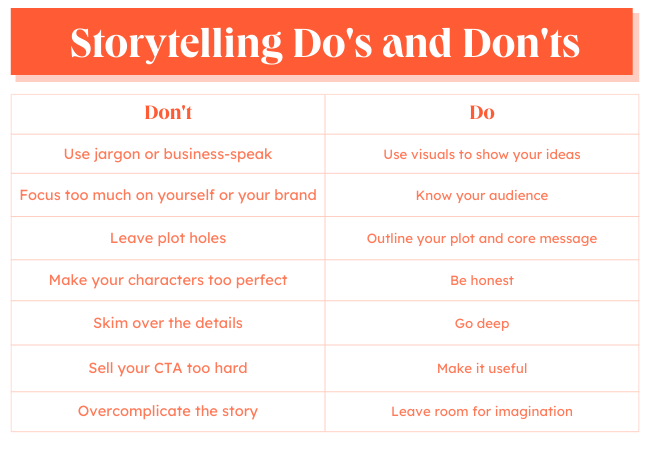
The Art of Storytelling
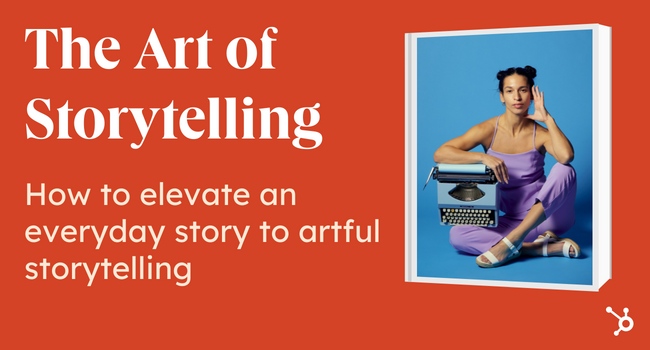
Narrative
Attention-Grabbing
Interactive
Imaginative
Why Do We Tell Stories?
Stories solidify abstract concepts and simplify complex messages.
Stories promote and shape ideas.
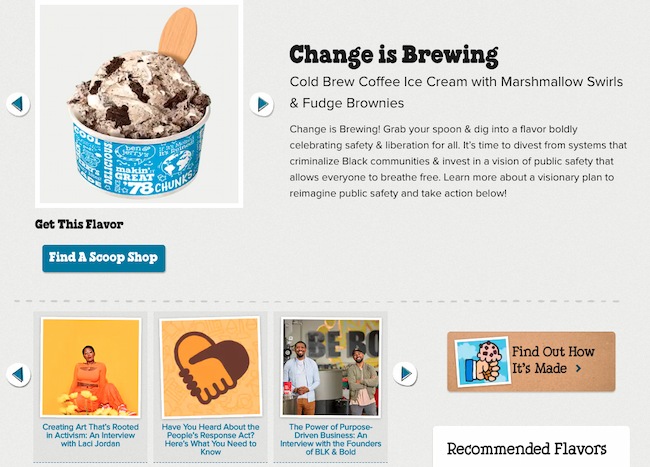
Stories bring people together.
Stories inspire and motivate.
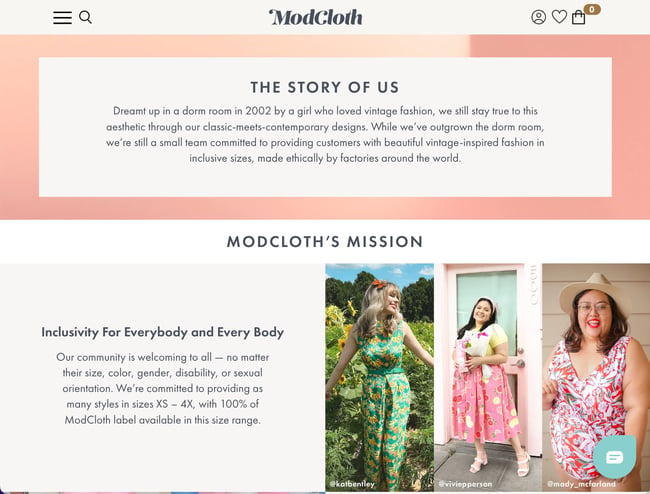
What makes a good story?
How to Tell Great Stories
1. Characters
2. Conflict
3. Resolution
4. Structure
5. Setting
The Storytelling Process
1. Know your audience.
2. Define your core message.
3. Decide what kind of story you’re telling.
Incite Action
Tell Your Story
Convey Values
Foster Community or Collaboration
Impart Knowledge or Educate
4. Establish your call-to-action.
5. Choose your story medium.
Writing
Speaking
Audio
Digital
6. Plan and structure your story.
7. Write!
7. Share your story.
1. Email
2. Social Media
3. Blogs
4. Video
Storytelling Resources
For Writing
Guide to Becoming a Better Writer
OEDb’s writing resources
How to Write a Blog Post
Copywriting 101
HubSpot’s list of writing tools
For Speaking
The TEDx Speaker Guide
How to Nail Interactive Presentations
Professional Presentation Tips
For Audio Stories
HubSpot’s guide on How to Start a Podcast
The Anatomy of a Perfect Podcast Episode
For Digital Storytelling
Ultimate Guide to Video Marketing
Examples of Interactive Storytelling
Website Examples of Storytelling
How Brands Are Reaching Gamers
Animoto
Ultimate Guide to Making Your Own App
Start Telling Your Story

 Aliver
Aliver 
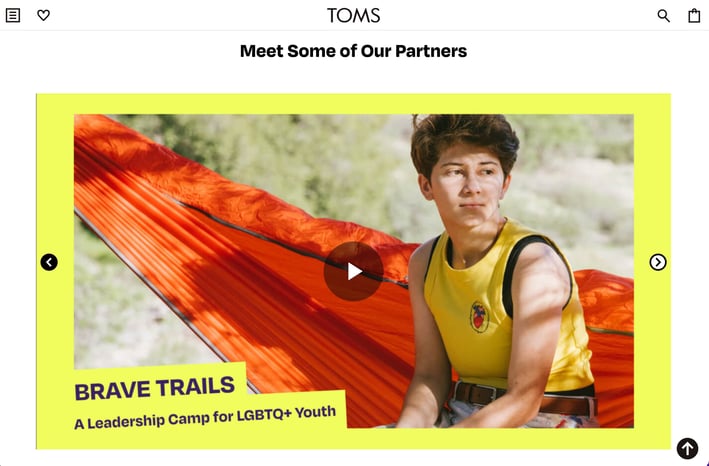










![How Apple iOS 15's Impacting Email Marketers [New Data]](https://blog.hubspot.com/hubfs/apple%20ios%2015%20email%20privacy%20impact%20data.jpg#keepProtocol)

.png)
